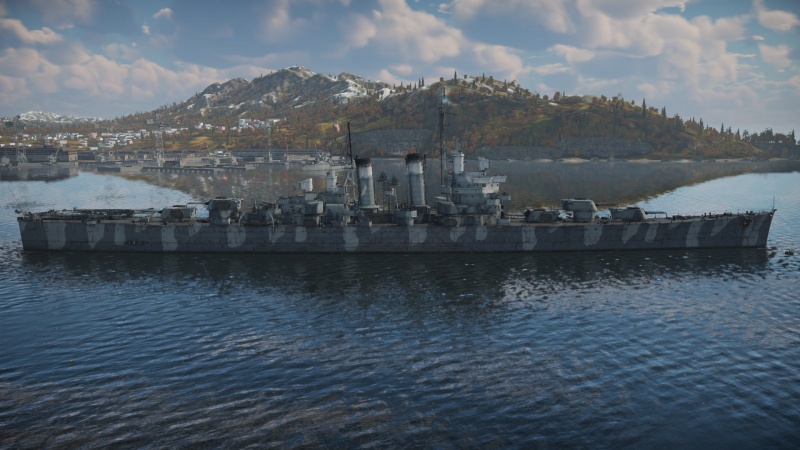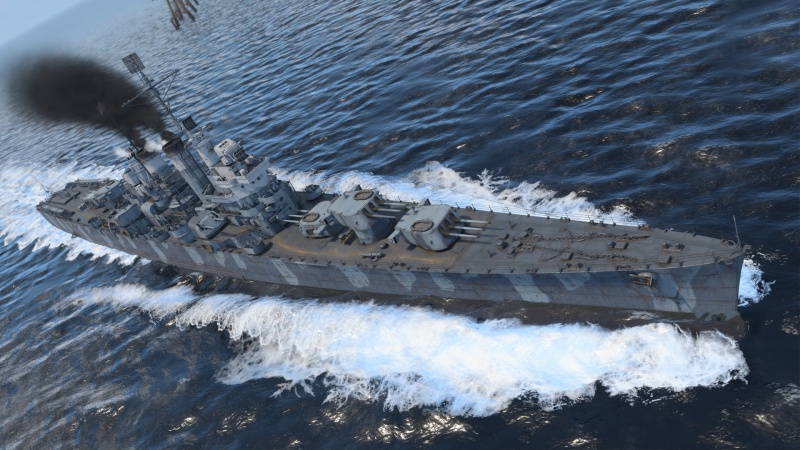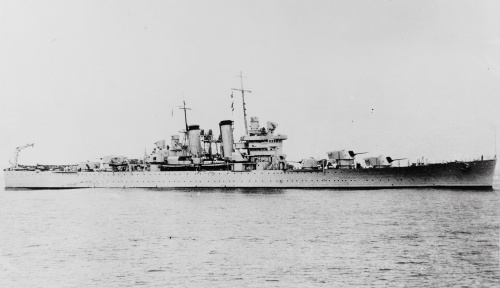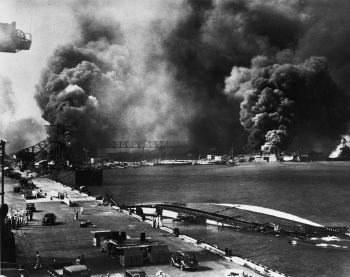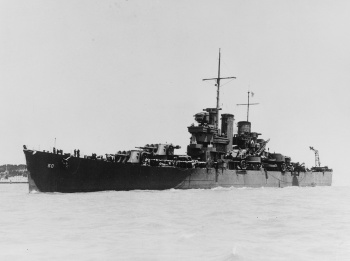Difference between revisions of "USS Helena"
U105837429 (talk | contribs) m (Undo revision 113651 by U105837429 (talk)) |
(Edits) |
||
| Line 1: | Line 1: | ||
{{Specs-Card | {{Specs-Card | ||
|code=us_cruiser_brooklyn_class_helena | |code=us_cruiser_brooklyn_class_helena | ||
| − | |images={{Specs-Card-Image|GarageImage_{{PAGENAME}}.jpg}} | + | |images={{Specs-Card-Image|GarageImage_{{PAGENAME}}.jpg|StoreImage_{{PAGENAME}}_001.jpg}} |
|store=9808 | |store=9808 | ||
}} | }} | ||
| Line 131: | Line 131: | ||
== Media == | == Media == | ||
| − | ''Excellent additions to the article would be video guides, screenshots from the game, and photos.'' | + | <!-- ''Excellent additions to the article would be video guides, screenshots from the game, and photos.'' --> |
| + | |||
| + | ;Skins | ||
| + | * [https://live.warthunder.com/feed/camouflages/?vehicle=us_cruiser_brooklyn_class_helena Skins and camouflages for the {{PAGENAME}} from live.warthunder.com.] | ||
== See also == | == See also == | ||
| − | ''Links to articles on the War Thunder Wiki that you think will be useful for the reader, for example:'' | + | <!-- ''Links to articles on the War Thunder Wiki that you think will be useful for the reader, for example:'' |
| + | * ''reference to the series of the ship;'' | ||
| + | * ''links to approximate analogues of other nations and research trees.'' --> | ||
| − | * | + | * [[USS Brooklyn]] |
| − | |||
== External links == | == External links == | ||
<!-- ''Paste links to sources and external resources, such as:'' | <!-- ''Paste links to sources and external resources, such as:'' | ||
* ''topic on the official game forum;'' | * ''topic on the official game forum;'' | ||
| − | |||
* ''other literature.'' --> | * ''other literature.'' --> | ||
Revision as of 08:56, 6 November 2021
Contents
Description
The Brooklyn-class, USS Helena (CL-50), 1943 is a premium rank American light cruiser with a battle rating of (AB), (RB), and (SB). It was introduced in Update 1.93 "Shark Attack".
General info
Survivability and armour
Armour on Helena is pretty strong for a light cruiser, as it can definitely hold out against large calibre HE shells. One should remember that Brooklyn-class cruisers oftentimes could survive a torpedo hit, so if you have enough crew, you can easily tank one or even two torpedoes. Your main concern while playing Helena should be high calibre AP shells, as they can wreck your ship in no time, especially if they are coming from fast reloading guns like American 5"/38, or if they are shot at you by a ship with lots of guns like IJN Suzuya.
Turret face armour is 165 mm, side, rear and top armour are 76 mm, 76 mm, and 51 mm thick respectively, and mantlets are 100 mm of RHA. Barbettes are 152 mm of rolled cemented armour. Secondaries are protected only by 32 mm of antifragmentation armour, so expect them to be knocked out as soon as any high calibre shell hits them.
Bow ammo magazines are protected by 51 mm of antifragmentation armour on the top and sides, and 127 mm of antifragmentation armour in the front. They are also hidden deep below the waterline and behind fuel tanks, which makes them a very difficult target. Aft shells and charges are protected from the top and rear by the same armour as bow magazines, but since there are no fuel tanks, they get 120 mm rolled cemented armour as side armour. Rear of the bow ammo stowage and front of the aft ammo stowage are protected by 95 mm of rolled cemented armour. Ammo elevators are protected by 127 mm of antifragmentation armour.
Bridge is protected by 127 mm of antifragmentation armour on the sides and 57 mm of the same armour on the top.
Thanks to the unit system (engines and boilers are alternating inside the hull) it's very hard to disable propulsion on the ship, even with a torpedo.
Mobility
Write about the ship's mobility. Evaluate its power and manoeuvrability, rudder rerouting speed, stopping speed at full tilt, with its maximum forward and reverse speed.
Modifications and economy
Armament
Primary armament
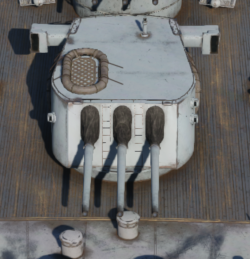
Helena carries a main armament of fifteen 6"/47 Mk.16 guns. As the standard main armament of American light cruisers, these guns are very effective anti-ship weapons. The guns are capable of firing at 10 rounds per minute (6-second reload), meaning that they have one of the highest fire rates for any 6 inch cannon (only the German triple 6-inch turrets fire faster at 12 rounds per minute). With the Helena's large main armament complement, this means that you can fire 150 shells per minute! The guns have good firing arcs and good ballistics as well for a gun of its size. However, they have a relatively slow turret traverse speed compared to its contemporaries. Helena's turrets are also well placed, though the #3 turret has relatively. bad firing arcs due to its location behind the #1 and #2 turrets.
The gun has access to four shell types - Mk.34 HC, Mk.35 AP, Mk. 34 HC with base fuse and Mk.34 HC-VT. Of these, the Mk. 35 AP is typically the best choice against armoured targets (i.e. heavy cruisers and battleships) as it is the only shell with good penetration values. The Mk.34 HC with base fuse could potentially be used against lighter-armoured cruisers, as it has superior penetration values compared to the original shell. Typically, one should take ~50% Mk.35 AP, ~40% Mk. 34 HC with base fuse, and ~10% Mk.34 HC-VT in case you want to attempt to shoot down aircraft with the main guns. The Mk.34 base fuse is superior to the original Mk.34 HC shell as it has better penetration values but retains the explosive mass.
Secondary armament
Helena is equipped with eight 5"/38 (12.7 cm) Mark 12 guns mounted in four dual-purpose turrets. These guns are extremely effective against surface and air targets alike, and are capable of firing at an obscene 22 rounds per minute while using first-stage ammunition. The weapon also has a very good vertical and horizontal rotation speed, and is capable of engaging aircraft due to its high-angle capability (up to 85 degrees).
Helena gets access to the standard three shell types - Mk.34 AAC, Mk.46 Common SP, and Mk.31 AAVT. The SP is typically the best pick for heavier-armoured targets such as cruisers, while the AAC shell works better against unarmoured targets due to its large explosive filler. The Mk.31 AAVT is a great option for dealing with air targets due to its proximity fuse - a single direct hit should be enough to destroy an incoming bomber.
Anti-aircraft armament
Helena gets access to sixteen 40 mm Bofors guns in four quad mounts. These weapons are extremely potent anti-aircraft guns due to their accuracy and punching power. Though these weapons fire slower than the 20 mm Oerlikon or 12.7 mm AN-M2, they more than make up for it due to their hard-hitting 40 mm shells. These guns are capable of shredding aircraft and small boats from ranges of 2.5 km away, though effectiveness will drop off after that range due to the large bullet drop. The guns fire from 4-round clips that reload continuously, meaning that they are capable of continuous fire. However, note that they will eventually jam after firing too long.
As well, Helena gets access to twelve single 20 mm Oerlikon cannons. The 20 mm Oerlikon Cannon was the standard light anti-aircraft gun for several nations, including the United States, and replaced the prior AN-M2 Browning machine gun. This weapon is an effective short-range AA gun, and has great firing angles. These guns are very helpful and can boost the volume of AA fire at shorter ranges. Take note that the guns fire from a drum magazine that will need to be reloaded. Because of the magazine design, the gun will not jam with continuous fire.
Usage in battles
Describe the technique of using this ship, the characteristics of her use in a team and tips on strategy. Abstain from writing an entire guide – don't try to provide a single point of view, but give the reader food for thought. Talk about the most dangerous opponents for this vehicle and provide recommendations on fighting them. If necessary, note the specifics of playing with this vehicle in various modes (AB, RB, SB).
Pros and cons
Pros:
- 2 x triple-mount 6 inch and 2 x dual-mount 5 inch cannons can fire straight ahead, allowing decent firepower while only exposing a small silhouette towards the enemy
- Extensive use of antifragmentation armour, rendering Helena as almost HE-"proof"
- Best citadel armour out of all light cruisers in the game
- One of the highest main calibre fire rates out of all light cruisers (10 rpm)
- Very hard to disable all of the engines with one torpedo hit, thanks to unit system of machinery (transmission and engines are alternated inside the ship)
- Highest ammo count out of all cruisers
- Shells and charges are hidden below waterline, are protected by loads of antifragmentation armour, rolled cemented armour and fuel, making it very hard to one hit kill Helena
- Second thickest turret face in the game (only Chapayev and Sverdlov have thicker turret armour)
- Second best AA in game in terms of amount of guns, best AA in game in terms of ammo and flexibility (out of all light cruiser that is)
- Mobility is comparable to other ships (except top tier Japanese and Italian cruisers)
- Bridge is protected by 127 mm of antifragmentation armour
- One of the highest crew counts in the game
Cons:
- Citadel and ammoracks are well armoured, but other parts of the ship are protected by only 16 mm of antifragmentation armour
- Detonation of forward magazines will destroy all shells for the front turrets, depriving the ship 3/5ths of its firepower
- There are some shells hidden inside barbettes, so unlucky hit may cause heavy fires or even one hit kill a ship
- Auxiliary turrets have their first stage ammo stowages unprotected, so unlucky hits may cause heavy fires
- Second worst 152 mm penetration in game (but it's still enough to kill any vessel)
- Turret No. 3 can shoot only when retreating or when showing broadside
- No torpedo armament
History
USS Helena (CL-50) was a ship of the Brooklyn class of light cruisers built for the United States during the early 1930s. As the first American cruisers built to the specifications of the London Naval Treaty, they were designed to counter the Japanese Mogami-class and featured a similar armament of fifteen 6-inch guns. Helena was completed to an altered design featuring improved machinery protection and greatly-improved anti-aircraft armaments. Helena was commissioned in 1939 and spent her first two years in training. She was torpedoed during the attack on Pearl Harbour, repaired, and returned to service. She saw extensive action and managed to damage or sink several Japanese ships during the Battles of Guadalcanal, but was sunk during the Solomons campaign when she was torpedoed by Japanese destroyers.
Design and development
As the London naval treaty limited the amount of heavy cruisers with 8-inch main armament, the American naval designers decided to create a ship displacing 10 thousand tons with a 6-inch main armament. As well, they found that a light cruiser with a 6-inch main armament could overwhelm a comparable heavy cruiser due to their higher fire rate. As a result, the designers pushed forward with a new 6-inch armament light cruiser: the Brooklyn class.
However, during Brooklyn's design process, it was discovered that the Japanese intended to arm their new Mogami class with fifteen 6-inch guns. As a result, the Brooklyn's design was amended to include an additional 3-gun turret mounted in a rear-facing non superfiring position. Helena was initially built to this design and was launched in August of 1938. However, she featured a revised machinery layout which improved her survivability, as well as a revised secondary armament of eight 5-inch/38 guns in dual enclosed mounts. Her anti-aircraft armament was initially unchanged, but was refitted significantly later on during the war.
Helena was 185 metres long and displaced exactly 10 thousand tons standard, and 13 300 tons full. She had a main armament of fifteen 6-inch (152 mm) guns in five triple turrets, three fore and two aft. The #3 turret, mounted ahead of the superstructure, faced backwards and was unable to fire forwards. Her secondary armament consisted of the aforementioned 5-inch (127 mm) guns, and her anti-aircraft armament initially consisted of eight 12.7 mm AN/M2 machine guns - later on, these would be augmented by several quadruple 28 mm "Chicago Pianos", and then replaced entirely with a heavy anti-aircraft suite of 40 mm Bofors and 20 mm Oerlikon cannons. Her engines delivered a total of 100 000 shaft horsepower (shp), allowing her a top speed of 32.5 knots (60 km/h).
Operational history
Helena was commissioned in December of 1939, after the start of the Second World War. Due to the neutrality of the United States, Helena participated in training exercises for the most part of 1939, 1940 and 1941. She sailed to Montevideo, Uruguay to inspect the wreck of the German pocket battleship Graf Spee, and then proceeded through the Panama Canal to join the Pacific Fleet. She was docked in the position normally reserved for the battleship Pensylvannia in December of 1941, as the battleship had been dry docked for repairs.
On December 7th 1941, the Japanese fleet attacked Pearl Harbour with a massive aerial attack. A pilot from the first wave mistook the Helena to be the battleship Pensylvannia, and hit her with a torpedo which caused severe damage. Despite this, the crews closed off flooded compartments and turned on the auxiliary generators, which allowed her 5-inch guns to return fire against the enemy. During this time, four other torpedo bombers attempted to hit the cruiser, but all missed. The second wave of bombers had worse luck, due to the determined anti-aircraft fire that the cruiser provided: at least four bombs missed, and Helena was credited with shooting down six aircraft, out of the 29 aircraft shot down in total by American forces.
Helena was given temporary repairs, and sailed for Mare Island in California for more complete repairs. There, she was given a new superstructure, and her anti-aircraft armament was completely redone. Her old 1.1-inch (28 mm) and 12.7 mm guns were removed and replaced with a combination of 16 40 mm Bofors guns and numerous 20 mm Oerlikons. After the completion of repairs, Helena sailed back to the Pacific to participate in the Guadalcanal campaign.
Guadalcanal campaign
After arriving in the Guadalcanal theatre, Helena joined a cruiser force tasked with destroying enemy ships in the Guadalcanal area. She soon saw her first combat action during the night of October 12 1942, when the force spotted a Japanese bombardment unit composed of the cruisers Furataka, Aoba, Kinugasa, and several accompanying destroyers; this action was to be known as the battle of Cape Esperance. Helena, along with the other cruisers, opened fire at 5 km range, at a point where the Japanese force were completely unaware of the American force. Helena, along with the other cruisers, were successful in hitting the Furutaka and destroyer Fubuki multiple times. Both ships were eventually destroyed later in the night.
After the battle of Cape Esperance, Helena was attached to a heavy unit tasked with defending an American convoy bound for the beaches of Guadalcanal. They arrived on November 12th, and Helena covered the landings. However, a Japanese force, centered on the fast battleships Hiei and Kirishima, was also approaching with the intention of shelling the American troops. As a result, these two forces collided in a battle known as the Naval Battle of Guadalcanal.
The ships encountered each other at close range, causing confusion among the American units. In the following engagement, Helena engaged the destroyer Akatsuki, which was then engaged by multiple vessels and sank. She then hit the destroyers Amatsukaze, Murasame and Samidare with 6-inch rounds, causing heavy damage. However, during this time, the flagship San Francisco had been hit by multiple heavy rounds from the battleship Hiei, and Helena rushed to protect her. In the following engagement, two American destroyers were sunk and 4 more ships heavily damaged; Helena herself emerged relatively unscathed. The Japanese squadron lost the battleship Hiei, as well as two destroyers. The surviving ships of the battered squadron retreated to the southeast; during this time, the cruiser Juneau was hit by a torpedo launched from the submarine I-26 which exploded her magazines and caused her to sink; however, Helena did not stop to pick up survivors as the squadron's commanding officer deemed her to be too precious to risk (since there was a submarine in the area).
Later service and sinking
In January of 1943, the Helena was assigned to a new unit to attack Japanese positions in the New Georgia campaign. During this time, her 5-inch guns received new HE-VT shells, which she fired as the first use of the proximity-fused shell in American service. She served extensively as a fire support ship, firing thousands of high-calibre shells in support of American troops.
On July 4th of 1943, Helena was part of an invasion squadron to land troops at Rice Anchorage. She proceeded to bombard the Japanese positions under the cover of darkness along with the other cruisers and destroyers, but her shell flashes alerted a force of three Japanese destroyers who had been tasked with landing reinforcements for the Japanese garrison. The destroyers withdrew, not before they fired 24 Type 93 'Long Lance' torpedoes at the Americans. Helena was not hit, but a destroyer was sunk and the convoy turned to avoid what was believed to be a submarine (the Americans failed to sight the Japanese destroyers). During this time, Helena's #2 ammunition hoist broke down and her #5 guns suffered a jam. These issues were resolved as she steamed towards the Kula gulf,
The next night, the Japanese force returned with 10 destroyers, intending to land the troops again. The American force closed in, and soon after, the Japanese force detected the American squadron using their radar. The Japanese force then began a determined attack with gunfire and torpedoes while the Americans fired back. In the course of 3 minutes, Helena, along with her other cruisers, fired over 1500 6-inch rounds at the enemy. The destroyer Niizuki was sunk, and the Americans turned right to follow the fleeing Japanese destroyers.
However, shortly after the initial engagement, Helena was hit by a torpedo launched by the Japanese destroyers. The torpedo caused extensive damage and exploded the forward magazines, ripping her bow off of the ship. However, she continued to steam forward at 25 knots. Soon after, she was hit by an additional pair of torpedoes deep under the waterline which broke her keel and flooded the machinery spaces - with no power, the order was given to abandon ship. Soon after, the broken keel caused Helena to break into three parts - the midsection sank quickly while the stern and bow remained afloat.
At this point, the American force had not yet realized that the Helena was destroyed - however, after failing to contact her, they found her wreck and rescued many survivors from the water. Over 100 men were not rescued and ended up on a Japanese-occupied island, where they were protected by coastwatchers and eventually rescued on July 15th. Helena's name was carried on by a Baltimore-class cruiser launched in 1945; her wreck was eventually located in 2018 by an expedition carried out by the late Microsoft founder Paul Allen.
Media
- Skins
See also
External links
References
- Chen, P. C. (2004). Heavy Cruiser Pensacola. Retrieved January 12, 2021, from https://ww2db.com/ship_spec.php?ship_id=144
- Naval History and Heritage Command. (2005, October 25). Helena II (CL-50). Retrieved January 12, 2021, from https://www.history.navy.mil/research/histories/ship-histories/danfs/h/helena-cl-50-ii.html
- Werner, D. (2018, April 06). USS Helena (CL 50): Ready, Willing and Valiant. Retrieved January 12, 2021, from https://usnhistory.navylive.dodlive.mil/2018/04/06/uss-helena-cl-50-ready-willing-and-valiant/
| Brooklyn Navy Yard | |
|---|---|
| Cruiser, Light (CL) | |
| Brooklyn-class | USS Brooklyn · USS Helena |
| Heavy Cruisers (CA) | |
| Pensacola-class | USS Pensacola |
| Battleships (BB) | |
| Pennsylvania-class | USS Arizona |
| USA light cruisers | |
|---|---|
| Omaha-class | USS Detroit · USS Raleigh · USS Trenton |
| Atlanta-class | USS Atlanta |
| Brooklyn-class | USS Brooklyn · USS Helena |
| Cleveland-class | USS Cleveland |
| Fargo-class | USS Fargo |
| Worcester-class | USS Roanoke |
| USA premium ships | |
|---|---|
| Motor torpedo boats | PT-3 · PT-109 · PT-174 · Thunderbolt (PT-556) · PT-658 · PT-811 |
| Motor gun boats | LCM(6) Zippo · USS Douglas · USS Flagstaff |
| Sub-chasers | Carmi (PC-466) |
| Destroyers | USS Welborn C. Wood · USS Wilkinson · USS Bennion · USS Cowell · USS Davis · USS Moffett · USS Phelps · USS Frank Knox |
| Light cruisers | USS Detroit · USS Helena |
| Heavy cruisers | USS Des Moines |
| Battleships | USS Arkansas |



